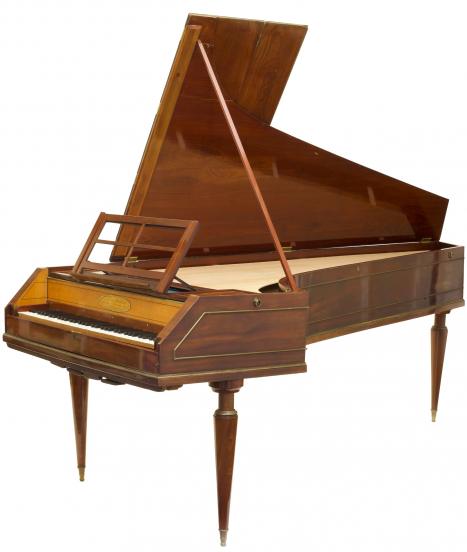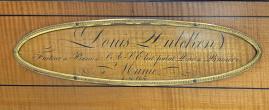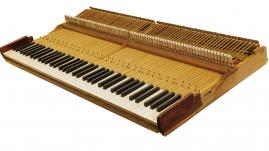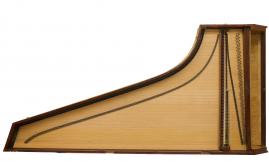Grand piano Louis Dulcken
München 1805
Grand piano, former possession of the Dukes of Thurn und Taxis
Mechanism: Viennese action
Range: 6 octaves, 73 keys (C 1 – c 4 )
Knee lever (from left to right): una corda, Bassoon, Dampers, Moderator
Stringing:
Brass: C 1 – A 1
Iron: B flat 1 – c 4
Signature:
„Louis Dulcken // Facteur de Piano de S. A. S. Elect. palat. Duc de Baviére // à Munic. // 1805“
Dimensions: LxWxH: 2394 x 1140 x 897 mm




Margarete Madelung:
"Heinrich Marchand, Louis Dulcken und das Haus Thurn und Taxis"
1998
A particular feature of this instrument is its atypical range, which has been expanded downwards, perhaps in order to perform popular contemporary harp repertoire on it. This assumption arises from the biography of the instrument’s then-owners, Prince Karl Alexander and Princess Therese of Thurn and Taxis, both of whom were ambitious musicians, the latter also being a passionate harpist. Furthermore, they took piano lessons from a student of Leopold Mozart and nephew of Louis Dulcken’s wife Sophie, Heinrich (Henry) Marchand, who arrived at the Regensburg court of Thurn and Taxis in the year of the couple’s wedding. It is likely that the commissioning for this grand piano, tailored to specific customer requests, went through him to the Munich court supplier Louis Dulcken.
The instrument is crafted in accordance with the late furniture style of Konrad David Röntgen, characterized by large mahogany surfaces and accents from brass strips and fittings. Comparable instruments by Dulcken from the same period and with the same design language, however, are made not with expensive mahogany, but with local woods and without brass ornaments. Additionally, the keys of the Thurn and Taxis grand piano are covered with precious ivory. These two decorative features, mahogany surfaces with brass inlays and ivory keys, also indicate English traditions, like those common with at the London piano manufacturing company Broadwood, which were already established before 1800. Consequently, in Germany, instruments with this specification were also referred to as "crafted after English masters" – and again the unusual keyboard range of the Thurn and Taxis grand piano from C1 to c4 again meets English custom. Once again, the company Broadwood was producing instruments with this range as early as before 1800, while in Germany, the standard range was five or five and a half octaves from F1 to f3/c4. The deviation from this norm and thus the special customer request from the princely couple of Thurn and Taxis can be seen in our instrument in the modification of the apparently existing keyboard frame in the bass area, where it has been extended downwards to C1.
Short description
Exterior
Internal
sound board
Measure
Keyboard
mechanism
Alterations
Further notifications
Louis Dulcken
Louis Dulcken (1761 - 1836) received his training in harpsichord and piano construction from his father, the son of the renowned Flemish harpsichord maker Johann Daniel Dulcken. When Louis Dulcken arrived in Munich in 1780, he became acquainted with the peculiarities of South German piano making as an assistant to the court piano maker Johann Peter Milchmeyer. Many essential components of one of the earliest surviving instruments from 1792 are constructed in the South German style, although in some areas the Flemish tradition also persists. The South German model for Dulcken seems to have been Johann Andreas Stein's; the technical details of construction in this early instrument show Stein's influence. Later, he also adopted features from the Viennese piano-making tradition of the Anton Walter school, such as brass capstans and the action rail.
During his lifetime, Louis Dulcken was the most famous piano maker in Munich, and his instruments were purchased throughout Europe and by noble circles. "The late Empress Josephine of France purchased two fortepianos from Mr. Dulcken during her visit to Munich and shortly thereafter ordered a third, with which people in Paris were so pleased that it was publicly displayed there for an extended period. Recently, a Dulcken instrument was sent to St. Petersburg, where it received general acclaim." (Kunst- und Gewerbeblatt 1820, p. 36)
He did not conform to the then-prevailing industrialization trends in piano making and emphasized the value of craftsmanship. This may also explain the renowned quality of his instruments; this piano from the Thurn and Taxis estate indeed showcases his extremely meticulous work.
aus: Felix Joseph Lipowsky, Baierisches Musik-Lexikon, München 1811, S. 70
"Dulken, (Johann Ludwig), wurde zu Amsterdam den 5. August 1761 geboren, lernte in seiner Vaterstadt, und dann in Paris von seinem Vater Klaviere, Fortepiano und dergleichen Instrumente bauen, und wurde von dem Churfürsten Karl Theodor als mechanischer Klaviermacher an seinem Hofe zu München 1781 angestellt, in welcher Eigenschaft er sich noch [1811] befindet, und daselbst den 18. April 1799 die berühmte Klavierspielerin Sophie Le Brün heirathete. Dieser Künstler erwarb sich durch seine vortreffliche Fortepiano, die einen reinen, sonoren Ton haben, eine andauernde Stimmung halten, und durch einen geschickten angebrachten Mechanismus Fagote, Harfe, Harmonika &c. nachahmen, die von Friederici in Gera erfundene Bebung vortrefflich en[t]halten, usw. auch sich durch eleganten und geschmackvollen Bau auszeichnen, große Celebrität, seine Instrumente sind sehr gesucht und willkommen, und finde zahlreichen Abgang nicht nur in ganz Deutschland, sondern auch in Frankreich, in der Schweiz, Italien, Rußland usw."
Durch seine Heirat mit der Pianistin Sophie Lebrun war Dulcken mit vielen bedeutenden Musikerfamilien aus dem Kreis des ehemaligen Mannheimer Orchesters in München und international direkt verwandt und verschwägert, darunter die Familen Danzi, Lebrun, Brunner, David.




